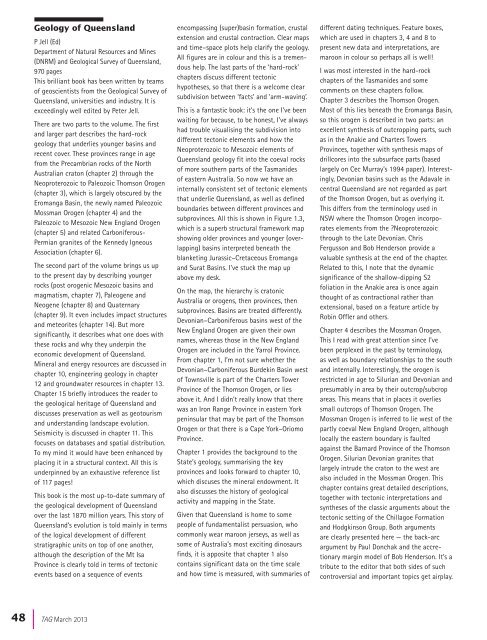TAG 166 - Geological Society of Australia
TAG 166 - Geological Society of Australia
TAG 166 - Geological Society of Australia
Create successful ePaper yourself
Turn your PDF publications into a flip-book with our unique Google optimized e-Paper software.
Geology <strong>of</strong> QueenslandP Jell (Ed)Department <strong>of</strong> Natural Resources and Mines(DNRM) and <strong>Geological</strong> Survey <strong>of</strong> Queensland,970 pagesThis brilliant book has been written by teams<strong>of</strong> geoscientists from the <strong>Geological</strong> Survey <strong>of</strong>Queensland, universities and industry. It isexceedingly well edited by Peter Jell.There are two parts to the volume. The firstand larger part describes the hard-rockgeology that underlies younger basins andrecent cover. These provinces range in agefrom the Precambrian rocks <strong>of</strong> the North<strong>Australia</strong>n craton (chapter 2) through theNeoproterozoic to Paleozoic Thomson Orogen(chapter 3), which is largely obscured by theEromanga Basin, the newly named PaleozoicMossman Orogen (chapter 4) and thePaleozoic to Mesozoic New England Orogen(chapter 5) and related Carboniferous-Permian granites <strong>of</strong> the Kennedy IgneousAssociation (chapter 6).The second part <strong>of</strong> the volume brings us upto the present day by describing youngerrocks (post orogenic Mesozoic basins andmagmatism, chapter 7), Paleogene andNeogene (chapter 8) and Quaternary(chapter 9). It even includes impact structuresand meteorites (chapter 14). But moresignificantly, it describes what one does withthese rocks and why they underpin theeconomic development <strong>of</strong> Queensland.Mineral and energy resources are discussed inchapter 10, engineering geology in chapter12 and groundwater resources in chapter 13.Chapter 15 briefly introduces the reader tothe geological heritage <strong>of</strong> Queensland anddiscusses preservation as well as geotourismand understanding landscape evolution.Seismicity is discussed in chapter 11. Thisfocuses on databases and spatial distribution.To my mind it would have been enhanced byplacing it in a structural context. All this isunderpinned by an exhaustive reference list<strong>of</strong> 117 pages!This book is the most up-to-date summary <strong>of</strong>the geological development <strong>of</strong> Queenslandover the last 1870 million years. This story <strong>of</strong>Queensland’s evolution is told mainly in terms<strong>of</strong> the logical development <strong>of</strong> differentstratigraphic units on top <strong>of</strong> one another,although the description <strong>of</strong> the Mt IsaProvince is clearly told in terms <strong>of</strong> tectonicevents based on a sequence <strong>of</strong> eventsencompassing (super)basin formation, crustalextension and crustal contraction. Clear mapsand time–space plots help clarify the geology.All figures are in colour and this is a tremendoushelp. The last parts <strong>of</strong> the ‘hard-rock’chapters discuss different tectonichypotheses, so that there is a welcome clearsubdivision between ‘facts’ and ‘arm-waving’.This is a fantastic book: it’s the one I’ve beenwaiting for because, to be honest, I’ve alwayshad trouble visualising the subdivision intodifferent tectonic elements and how theNeoproterozoic to Mesozoic elements <strong>of</strong>Queensland geology fit into the coeval rocks<strong>of</strong> more southern parts <strong>of</strong> the Tasmanides<strong>of</strong> eastern <strong>Australia</strong>. So now we have aninternally consistent set <strong>of</strong> tectonic elementsthat underlie Queensland, as well as definedboundaries between different provinces andsubprovinces. All this is shown in Figure 1.3,which is a superb structural framework mapshowing older provinces and younger (overlapping)basins interpreted beneath theblanketing Jurassic–Cretaceous Eromangaand Surat Basins. I’ve stuck the map upabove my desk.On the map, the hierarchy is cratonic<strong>Australia</strong> or orogens, then provinces, thensubprovinces. Basins are treated differently.Devonian–Carboniferous basins west <strong>of</strong> theNew England Orogen are given their ownnames, whereas those in the New EnglandOrogen are included in the Yarrol Province.From chapter 1, I’m not sure whether theDevonian–Carboniferous Burdekin Basin west<strong>of</strong> Townsville is part <strong>of</strong> the Charters TowerProvince <strong>of</strong> the Thomson Orogen, or liesabove it. And I didn’t really know that therewas an Iron Range Province in eastern Yorkpeninsular that may be part <strong>of</strong> the ThomsonOrogen or that there is a Cape York–OriomoProvince.Chapter 1 provides the background to theState’s geology, summarising the keyprovinces and looks forward to chapter 10,which discuses the mineral endowment. Italso discusses the history <strong>of</strong> geologicalactivity and mapping in the State.Given that Queensland is home to somepeople <strong>of</strong> fundamentalist persuasion, whocommonly wear maroon jerseys, as well assome <strong>of</strong> <strong>Australia</strong>’s most exciting dinosaursfinds, it is apposite that chapter 1 alsocontains significant data on the time scaleand how time is measured, with summaries <strong>of</strong>different dating techniques. Feature boxes,which are used in chapters 3, 4 and 8 topresent new data and interpretations, aremaroon in colour so perhaps all is well!I was most interested in the hard-rockchapters <strong>of</strong> the Tasmanides and somecomments on these chapters follow.Chapter 3 describes the Thomson Orogen.Most <strong>of</strong> this lies beneath the Eromanga Basin,so this orogen is described in two parts: anexcellent synthesis <strong>of</strong> outcropping parts, suchas in the Anakie and Charters TowersProvinces, together with synthesis maps <strong>of</strong>drillcores into the subsurface parts (basedlargely on Cec Murray’s 1994 paper). Interestingly,Devonian basins such as the Adavale incentral Queensland are not regarded as part<strong>of</strong> the Thomson Orogen, but as overlying it.This differs from the terminology used inNSW where the Thomson Orogen incorporateselements from the ?Neoproterozoicthrough to the Late Devonian. ChrisFergusson and Bob Henderson provide avaluable synthesis at the end <strong>of</strong> the chapter.Related to this, I note that the dynamicsignificance <strong>of</strong> the shallow-dipping S2foliation in the Anakie area is once againthought <strong>of</strong> as contractional rather thanextensional, based on a feature article byRobin Offler and others.Chapter 4 describes the Mossman Orogen.This I read with great attention since I’vebeen perplexed in the past by terminology,as well as boundary relationships to the southand internally. Interestingly, the orogen isrestricted in age to Silurian and Devonian andpresumably in area by their outcrop/subcropareas. This means that in places it overliessmall outcrops <strong>of</strong> Thomson Orogen. TheMossman Orogen is inferred to lie west <strong>of</strong> thepartly coeval New England Orogen, althoughlocally the eastern boundary is faultedagainst the Barnard Province <strong>of</strong> the ThomsonOrogen. Silurian Devonian granites thatlargely intrude the craton to the west arealso included in the Mossman Orogen. Thischapter contains great detailed descriptions,together with tectonic interpretations andsyntheses <strong>of</strong> the classic arguments about thetectonic setting <strong>of</strong> the Chillagoe Formationand Hodgkinson Group. Both argumentsare clearly presented here — the back-arcargument by Paul Donchak and the accretionarymargin model <strong>of</strong> Bob Henderson. It’s atribute to the editor that both sides <strong>of</strong> suchcontroversial and important topics get airplay.48 |<strong>TAG</strong> March 2013
















